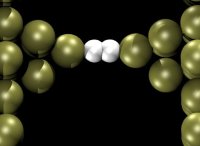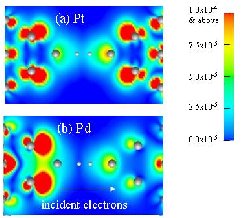Contact dependence of the conductance of H2 molecular junctions
Collaborator: Steven G. Louie, Molecular Foundry

Model H2 nanojunction geometry. The H atoms are shown in white, Pt or Pd atoms in gold. The interslab distance, H-H atom distance and tip-atom to hydrogen distance are determined by minimizing the total energy.
Metal-molecule contacts are known to play a critical role in determining the low-bias transport properties of molecular electronic devices. Recent break-junction experiments have reported that the conductance of H2 molecular junctions dropped by more than a factor of two (from 1 G0 to ~ 0.4 G0, where G0 = 2e2/h is the conductance quantum) when Pt contacts were simply replaced with Pd. Shot-noise and inelastic tunneling measurements further showed that there is only one conducting channel, and that the H2 molecule is involved and arranged in the junction with its bond axis aligned parallel to the transport direction, bridging the Pt contacts. Given the similarity of the two metals, the reduction in conductance by a factor of two or three for Pd is surprising; the result was initially attributed to a drop in density of states due to a hydrogen-doping of the Pd leads.
Several recent theoretical calculations have corroborated the findings of the Pt experiment, predicting large values of conductance of order 0.1 – 1.0 G0. Although two theoretical works are consistent with the hypothesis that Pd leads lower the conductance, they did not explain the sensitivity of the H2 junction conductance to the choice of contacts.

Density plot of the transmitting scattering state in a plane containing the H2 molecule for the (a) Pt- H2 system & (b) Pd- H2 system. Scattering states are incident from the left.
Using an atomistic quantum scattering-state approach accounting for any junction chemistry that might take place, we calculated the electrical resistance of this molecular junction. We observe that the resistance of the H2 molecule in this arrangement is extremely sensitive to the choice of contact material, a trait not seen in macroscopic junctions. This behavior is explained by the fact that the metal atoms bridging the molecule tightly control the amount of current through the junction. In fact, replacement of Pd by Pt in exactly the same geometric arrangement enhances the conductance of the junction by a factor of 3, in agreement with experiments. Our work demonstrates that it is possible to manipulate the electrical conductance of single-molecule junctions by changing the contact material.


